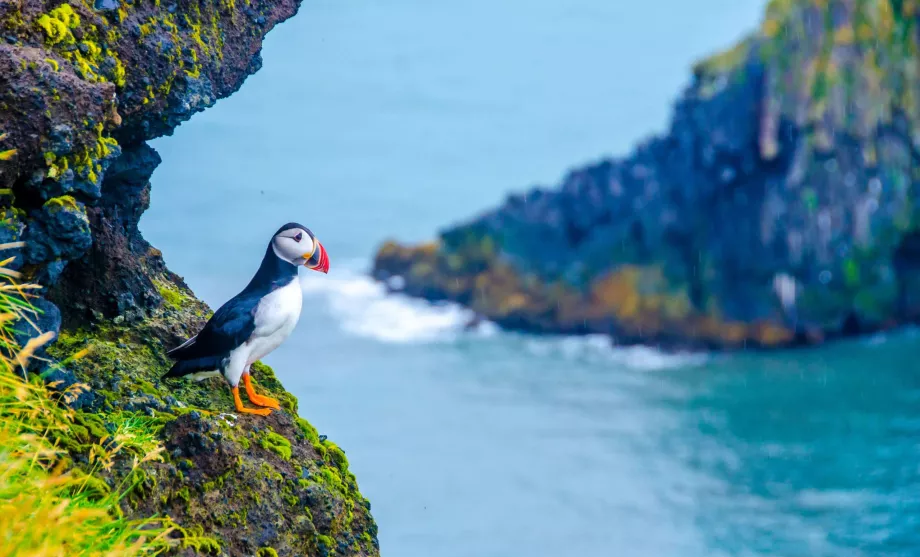Weather in Iceland and best time to go

Although Iceland is close to the Arctic Circle, its climate is mild for this latitude. The main contributor to the milder climate is the Gulf Stream, which causes temperatures to reach 14°C from June to the end of August in the south-western part of the island and stay at zero in winter. However, the constant winds can make it seem slightly colder than the thermometer indicates.
In Iceland, the sun doesn't show in the sky for very long in winter. However, you can see the Northern Lights, which are normally visible from October to March. See the chapter on tips for observing:
In early summer, on the other hand, you can watch the midnight sun setting and rising endlessly.
As Iceland's weather can be dangerous, we definitely recommend checking safetravel.is for alerts and warnings of dangerous phenomena.
Check the weather forecast for Iceland on the official Icelandic Meteorological Service website en.vedur.is.
Southwest vs. the rest of the island
Iceland can be divided into three parts according to the type of climate.
- Southwest - due to the influence of the Gulf Stream, winters are milder, snow cover is weaker and summers are the warmest on the island, with temperatures rarely exceeding 19 °C. It often rains, but mostly in the form of rain showers. Winter temperatures are usually around 0 °C. The southernmost part of the island is the sunniest (Vík í Mýrdal) and the Vestmannaeyjar archipelago.
- The centre (Icelandic Highlands) - a harsh climate of mountains and volcanoes reaching heights of 1 000 to 2 000 metres, lots of snow in winter, melting glaciers in summer. The centre of Iceland is usually completely inaccessible and cut off from the world throughout the winter; summer is short, lasting mostly from June to mid-September.
- North and East - The climate on the north and east coasts is much milder than in the centre of the island, but harsher than in the south and west. Temperatures in winter are harsh and can drop to -25°C, while summers are cool and short.
Iceland during the year
Sunrise and sunset times listed below are approximate and vary by up to half an hour between the northern and southern parts of Iceland.
Weather in January
January is the coldest month of the year, with average temperatures between -3 °C and 3 °C in the south of the island and -6 °C to 1 °C in the north and east. There are strong winds which make the temperature feel much lower, and it often snows heavily in the mountains, with snow regularly above 500 metres in the south-west, but otherwise rain and snow often fall and it is often completely overcast for many days at a time.
- Sunrise time (first and last day of the month) - approx. 11:30, 10:10
- Sunset time (first and last day of the month) - approx. 15:15, 17:00
Much of the tourist attractions in the centre and west of the island are completely inaccessible. It is only possible to move comfortably along the main roads. In the north and centre of Iceland, freezing temperatures below -15 °C are no exception.
Weather in February
Weather forecasts in Iceland are generally quite challenging and this is doubly true in February, which is one of the least predictable months of the year. The only certainties are average temperatures of around -3 °C to 3 °C, with the north still about 3 degrees lower.
Otherwise, sunny, heavy rain, heavy snow, freezing and above-zero temperatures, strong hurricanes and no wind can alternate rapidly during the day. February, in short, can show all aspects of Icelandic weather at its harshest. On the other hand, it is in the second half of February that the best conditions for aurora viewing occur.
- Sunrise time (first and last day of the month) - approx. 10:10, 9:10
- Sunset time (first and last day of the month) - approx. 17:00, 18:00
Weather in March
March is still a winter month in Iceland, but with rapidly increasing daylight hours. Expect normal temperatures between -2°C and 4°C, with strong winds as always, but not as unpleasant as in the middle of winter.
The weather changes rapidly during the day, with rain, snow and sunshine often. With the sun always low on the horizon, it creates a magical play of light and shadow in the morning and early evening. The ice caves in Skaftafell, for example, are beautiful in March. The beginning of March is still a good time to see the strong aurora borealis.
- Sunrise time (first and last day of the month) - approx. 8:30, 6:40
- Sunset time (first and last day of the month) - approx. 18:30, 20:10
All inland roads and most secondary roads in the Westfjords areas are closed and main roads may be icy. March is a popular month for skiing.
Weather in April
April average temperatures in southern Iceland finally break above freezing, ranging between 1°C and 6°C. Snow is already exceptional in the southern parts, but the north and the Icelandic highlands are still hidden under high drifts, so most mountain roads are still closed.
Precipitation is decreasing and mostly rain/snow in the form of quick showers with frequent sunny "windows". As April is no longer the aurora season and conversely summer is far from over, accommodation prices are among the lowest of the year.
- Sunrise time (first and last day of the month) - approx. 6:30, 4:50
- Sunset time (first and last day of the month) - approx. 20:15, 21:45
Weather in May
Iceland in May is marked by slowly rising temperatures, with a daily average of around 6°C, but double-digit figures are increasingly common in weather forecasts. The weather can be described as "intermittently cloudy, intermittently rainy"... just like any other month of the year. But the fact is that the extremes of the weather moderate in May, with extra strong winds rarely occurring. All-day frosts occur only high in the mountains.
The first campsites open in May, and some mountain roads open at the end of the month. From the second half of May, the first leaves appear on the trees and the grass starts to turn green.
- Sunrise time (first and last day of the month) - approx. 4:45, 3:00
- Sunset time (first and last day of the month) - approx. 21:50, 23:30
From the second half of May onwards, you won't experience a completely dark night in Iceland, although it still gets significantly darker for at least 2-3 hours in the middle of the night.
Weather in June
June in Iceland could be described as the first month of summer. Daytime temperatures normally hover around 13°C, but in the south can rarely approach 20°C. June is the least rainy month, but the chances of a few drops falling at least once a day are very high, so bring your jackets.
Iceland's landscape is lush green, with snow receding from the mountains and the last of the mountain roads and campsites opening up. June is also the most famous month for the midnight sun.
- Sunrise time (first and last day of the month) - approx. 3:00, 2:00
- Sunset time (first and last day of the month) - approx. 23:30, 0:15
As the whole of Iceland lies below the Arctic Circle, the full sun always disappears over the horizon for at least an hour, but throughout the night it is as light as a normal sunrise or sunset, and don't expect night-time gloom or even darkness.
Weather in July
Statistically, July is the hottest month in Iceland, with an average of around 15°C (59°F), and in extreme cases in the south the temperature can be above 20°C (68°F). With occasional rain showers and sun alternating with clouds for much of the day, July is one of the best months to travel around Iceland.
All roads are open, with snow only on the highest parts of the mountains and glaciers. On the other hand, the melting glacial caves are closed and can be dangerously unstable.
- Sunrise time (first and last day of the month) - approx. 2:00, 4:15
- Sunset time (first and last day of the month) - approx. 0:15, 22:30
Even during July you will never experience a dark night, it only gets darker in the middle of the night towards the end of the month, but still not enough to need to turn on outdoor public lighting.
Weather in August
August can be described as the last month of summer. Temperatures are still at a comfortable 14°C, there is virtually no snow anywhere in Iceland and the only rain is in the form of showers. Even during August you have a good chance of sunny weather for at least part of the day. In the north and east, temperatures can soar above 18 °C in August.
However, the differences between day and night are beginning to be felt, both in temperatures and daylight. Nature is still lush green. Unless it is a year-round grey volcanic landscape.
- Sunrise time (first and last day of the month) - approx. 4:15, 5:50
- Sunset time (first and last day of the month) - approx. 22:30, 20:40
Weather in September
September is the month when the summer season ends in Iceland. Temperatures drop to 12 °C, but frost does not appear except in the highest parts of the mountains and snow only rarely falls during the night. Rain showers and cloudy skies are becoming more frequent, but rarely unpleasant enough to significantly affect a holiday.
Thanks to the warm Gulf Stream, relatively high temperatures will hold until the end of the month, but it is starting to blow harder, so warmer clothing will be needed. The few trees that do grow in Iceland are turning beautiful autumnal shades, but the meadows remain evergreen.
- Sunrise time (first and last day of the month) - approx. 5:50, 7:20
- Sunset time (first and last day of the month) - approx. 20:40, 19:00
Most campsites usually close at the end of September.
Weather in October
October is the month when average temperatures return to single digits around 8°C, about a degree lower in the north. There are often torrential downpours lasting more than an hour, but on the other hand it rarely rains all day. Snow is still a rare occurrence in coastal areas, but in the mountains it is already starting to snow regularly and the first secondary roads are closing.
The trees (usually only in the cities, as there are none in the countryside) are colourful, the grass is slowly turning brown. At the end of the month there is a chance of seeing the Northern Lights, but you can still enjoy the relatively long daylight hours.
- Sunrise time (first and last day of the month) - approx. 7:20, 9:00
- Sunset time (first and last day of the month) - approx. 19:00, 17:00
Weather in November
In November, winter in Iceland is already making its presence felt. The average temperature in the south hovers around 0 °C, in the north and east around -1 °C. It is snowing more and more often in the lowlands, the sky is cloudy most of the day and the sun's rays reach the surface mainly on the south and west coasts.
November is one of the most unpredictable months, the weather changes very quickly, with heavy rain followed by heavy snow, wind followed by no wind and a few rays of sunshine.
- Sunrise time (first and last day of the month) - approx. 9:00, 10:50
- Sunset time (first and last day of the month) - approx. 17:00, 15:30
Weather in December
December is the darkest month in Iceland. Temperatures average around -2 °C and around -4 °C in the north. By December, it is already snowing regularly all over the island, with only the very southwest around Reykjavik experiencing the occasional rain shower.
The long nights make December a good month for aurora viewing, but the downside is the frequent and long overcast skies, which logically makes viewing impossible. The ideal activity for December is exploring glacial caves, which are safe and stable due to the frozen ice.
- Sunrise time (first and last day of the month) - approx. 10:50, 11:30
- Sunset time (first and last day of the month) - approx. 15:30, 15:15
Many secondary roads are impassable and the centre of the island is almost completely inaccessible, as are large parts of the Westfjords peninsula.
Table of temperatures during the year
Reykjavik - Warm up your bones in the thermal springs
When to go to Iceland
The busiest months are June, July and August, mainly due to warmer weather and long days. Most museums, campsites and other tourist attractions are open during the summer months. If you want to be most assured of at least a few hours of sunshine and really long, bright days that can be made the most of for exploring Iceland's nature, then go during these months.
Buy discount tickets in the low season
However, if your main goal is to see the Northern Lights or go skiing, for example, go to Iceland exclusively in winter. Generally, the best conditions for aurora viewing are in November/December, and then especially in February/March, when it's dark enough but there's a good chance of broken skies.
However, if you go in November or December, you won't get much daylight. In addition, there are often long days of overcast skies during December and January, thwarting any chance of seeing the Northern Lights.
Any questions left?
If you have any questions or comments about the article...

